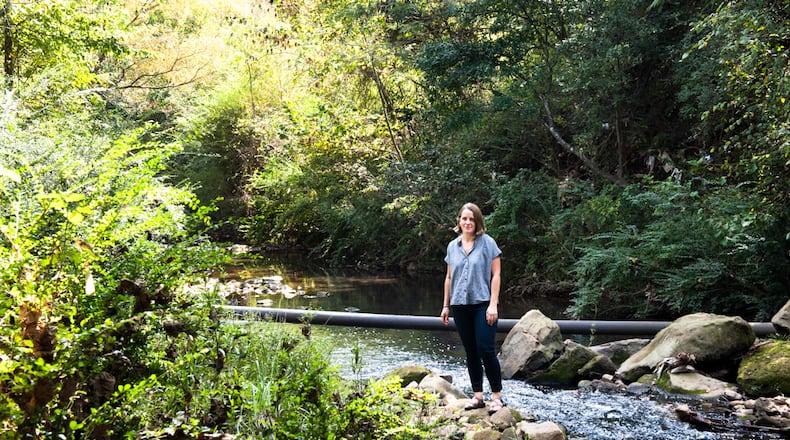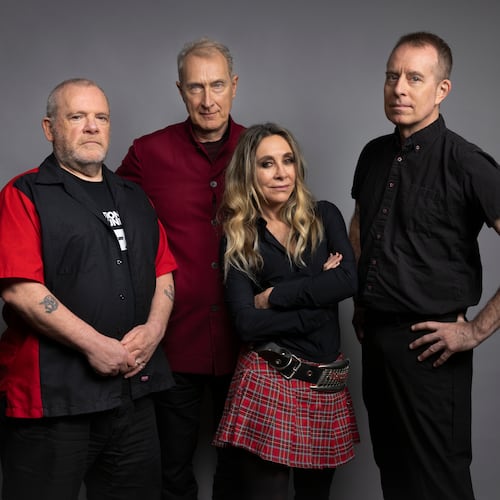For many of us, pools are synonymous with the pleasures of summer: Swimming lessons. A heart-stopping plunge in icy water on a stifling hot day. Games of Marco Polo. Perfecting your crowd-spraying cannonball.
But swimming pools are also a symbol of a divided country.
As historian Jeff Wiltse writes in his book “Contested Waters: A Social History of Swimming Pools in America,” American pools have often been a battleground where “white swimmers imposed and enforced racial segregation through violence.”
Swimming pools that closed in the aftermath of integration are at the heart of East Point writer Hannah Palmer’s collaborative public art installation “Ghost Pools,” which runs through Labor Day.
“Ghost Pools” is a multimedia experience produced by Flux Projects that takes place on the sites of two former East Point pools, the Spring Avenue Pool on the grounds of the East Point Historical Society and Museum and the Randall Street Pool in a parking lot of the John D. Milner Athletic Complex.
Credit: Handout
Credit: Handout
According to Palmer, they were the only two pools in East Point, both built in 1954 — one for Blacks and one for whites, which was double the size of the Black pool.
For “Ghost Pools,” blue paint, cheerful blue and white garlands, diving boards and signage indicate where the pools once stood.
The installation kicks off with an opening night of dance, music and food at 5-10 p.m. Saturday, June 3. Throughout the run of the installation, Palmer, 44, will hold occasional “activations” at these two historical sites that will combine oral history recordings, sound art, dance parties and film screenings.
But any time during the run, viewers can observe the sites and use their phones and a QR code to play a soundtrack of poolside revelry — children’s voices and splashing water — created by Atlanta composer and musician Santiago Páramo.
“Ghost Pools” is part of Flux Projects’ “Flow,” a multi-year, multi-project series through 2025 dedicated to examining Atlanta’s history with water and how it intersects with issues of conservation, urban design and social justice. Participating artists include Palmer, Gyun Hur, Jonathon Keats, Sue Schroeder and Rachel Parish.
“What happened in East Point was a pattern across the nation,” says Palmer. As Black residents attempted to integrate white pools, they were often met with violence. And often, rather than integrate, many pools for white residents simply shuttered.
“By the late 1970s, the (East Point) pools were in serious disrepair and needed hundreds of thousands of dollars worth of repairs. Voters refused to approve a referendum to pay for those repairs, so the pools had to close in 1982. Both of them,” says Palmer.
She encourages visitors to “Ghost Pools” to read about the history of the pools, explore the space, recall their own memories of swimming and think about the emotional connections they have to those memories.
Credit: Handout
Credit: Handout
“There’s an older generation that knows the history — they lived it,” says Palmer, who hopes the project will inform younger generations who are less familiar with these stories.
“I started this project because I was looking for a place for my kids to learn to swim. And I was really frustrated that there used to be a pool within walking distance of our house. Instead, we have a history museum that really wasn’t fully telling the story of the swimming pools,” she says. “I think learning to swim is just a life skill that everyone should have the privilege of attaining.”
Unfortunately, it is a life skill often unavailable to Black and brown communities.
Palmer points out that pools aren’t simply a luxury. They are also a necessity when you consider how many Black children never have access to basic water safety. According to the Centers for Disease Control, drowning rates for Black children ages 10-14 are 3.6 times higher than the rates for white children.
Flux Projects executive director Anne Dennington calls Palmer the “Ryan Gravel of water” for the way she has used Atlanta-area waterways to highlight the city’s vast and untapped potential while also illuminating the pitfalls of overlooking the lessons of the past.
For Gravel it was a long-abandoned railroad line that would unite disconnected neighborhoods. His Georgia Tech master’s thesis became Atlanta’s beloved Beltline.
For Palmer, it has been the Flint River, whose headwaters lie beneath East Point and the asphalt at Hartsfield Jackson.
“I’m really interested in water and the way it shapes cities and the way it kind of shapes our lives,” says Palmer. “A lot of the water in Atlanta is hidden. And it’s literally just out of reach and out of touch.”
That is the subject of her next book, a work in progress. In addition, Palmer works with Finding the Flint, a project created by American Rivers, The Conservation Fund and the Atlanta Regional Commission, to identify the tributaries of the Flint throughout Atlanta’s Southside. The mission is to create green space and public access to nature as part of the airport’s Aerotropolis initiative to redevelop land around Hartsfield Jackson. That engagement with the natural world is especially critical for Black or underprivileged segments of the population denied access to green space in Atlanta’s rapid gentrification.
“I admit, I do see a massive disparity between what we have here, south of I-20, and what’s booming up in the northern suburbs. So I do feel called to bring attention and do the work here in my own home. Anything I can do to lift up my community, that’s what I’m hoping for.”
Credit: Handout
Credit: Handout
Like much of Palmer’s work, “Ghost Pools” centers on Atlanta’s Southside, a beloved home for Palmer and her family but also a fruitful laboratory for examining race relations, gentrification and environmental neglect.
Palmer is the author of the 2017 memoir “Flight Path: A Search for Roots Beneath the World’s Busiest Airport,” a remembrance of how Hartsfield Jackson International Airport erased neighborhoods and communities as it grew. Three of Palmer’s own childhood homes were lost to that expansion.
Whether writing odes to those “ghost neighborhoods,” the Olympic Cauldron in Summerhill or cheap Ponce de Leon dining nexus Eats, Palmer has made highlighting Atlanta’s hidden, often abandoned places her mission so that residents can better understand the city’s past and present.
By bringing people together, Black and white, old and young in “Ghost Pools,” she also hopes to show the potential for a new form of community. Those swimming pools represented a massive investment of municipal funds in public space, says Palmer, who longs for a future when public money is dedicated to shared, joyful spaces that embrace the entire community.
“Currently there is a proposal to build an aquatic center in East Point on some property just outside of 285. I’m really excited — I hope that this project brings some awareness to the need for a city the size of East Point — there should be three or four (pools).
“We need schools, we need roads, we need sewage. But a pool — it’s just joyful,” she says. “It’s fun. It’s a collective community space where people go to relax and play and learn and cool off.
“I just think we deserve it.”
EVENT
“Ghost Pools.” Through Sept. 10. Free. Randall Street Pool: John D. Milner Athletic Complex, 3009 Randall St., East Point. Corner of Randall and R.N. Martin streets. Spring Avenue Pool: East Point Historical Society and Museum, 1685 Norman Berry Drive, East Point. At parking lot entrance off Lester Street. fluxprojects.org.
Opening event. Featuring performances by Ballethnic and Friends, food from Sweet Auburn BBQ and King of Pops and a dance party. Admission free. 5-7 p.m. Saturday, June 3. at Randall Street Pool and 7:30-10 p.m. at Spring Avenue Pool.
Oral History Recording Sessions with Ann Hill Bond. 11 a.m.-1 p.m. June 17, July 15, Aug. 19. East Point Historical Society and Museum, 1685 Norman Berry Drive, East Point.
About the Author
Keep Reading
The Latest
Featured




